We loved our time in Charleston for myriad reasons. I’ll list just three.
1. It’s a truly beautiful and picturesque town bursting with history critical to the founding and development of this country (and other countries, too) with many structures dating to the 1600s. It has a European feel – lots of tight streets, hidden gardens, gorgeous old-style homes.
2. We were blessed by the hospitality of kind friends in Dallas who invited us to stay in their unoccupied townhome in the heart of this historic peninsula. We broke with our usual preference for staying in our own Casita bedroom, left the trailer in the suburbs, and reveled in a week of downtown living amid fragrant star jasmine, geraniums, lovely lobelia and dainty sweet alyssum.
3. We made new friends via another Apple class – they’re from LA who spend every spring in Charleston – and hooked up unexpectedly with old friends from Dallas, who just happened to be passing through the city on their own cross-country RV trip. Two wonderful meals a la Georges with warm and fascinating people in our “Charleston home.” What could be better?
(Oh yeah, and an impromptu dental appointment was a success. Nothing like a medical win on the road.)

Neither Georges nor I had been to Charleston before. We’d enjoyed Savannah tremendously and were intrigued by our host-friend’s comparison of the two Old South cities:
Charleston is about sunshine, Savannah is about shade. Charleston is 18th century, Savannah is 19th century.
I think he’s right. (He was responding, in part, to the comparison of the two cities offered by John Berendt, author of Midnight in the Garden of Good and Evil, which I quoted in the middle of the blog post before this one.) Both cities ooze with history and mystique. Savannah revels in its insularity and obsession with streetscapes and parties. Charleston, bound by its own traditions and customs, looks outward and invests in its institutions of higher learning to enhance its economic recovery.

Below is some additional detail about each of reasons we loved our time in Charleston.
Beautiful and historic
We spent days walking and walking and walking. We covered the historic part of the peninsula – maybe about two miles by two miles – several times over and never tired of the views, the houses, the people.
I think of Charleston’s history as significant to the Civil War. After all, South Carolina was the first state to declare independence and secede from the U.S., helping to trigger the Civil War.
But the city also played a significant role in the founding of our country. It was Henry Middleton of Charleston who was chosen to preside over the First Continental Congress in 1744; his plantation is now a National Historic Landmark.
And while the city still seems to go light on its role in America’s brutal history of slavery, it does pay homage to several important players in the Civil Rights movement. Here’s just one example.
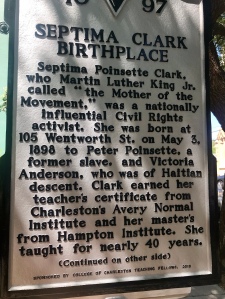

It was graduation weekend for Charleston College while we were there and one morning we chatted up the foreman prepping the school’s garden for the ceremony – all 3,800 white garden chairs of it. We learned that this school, which now has some 12,000 students, ranks fifth in the nation for four-year graduation rates and that instead of caps and gowns the graduates wear white tails and gowns. (We also learned that this building was featured in the movie The Patriot starring Mel Gibson.)
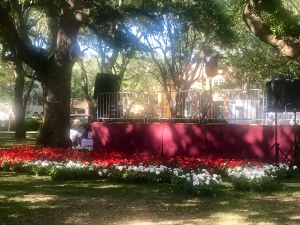

One day we took an organized city tour. Roy, a native of Charleston and a graduate of Charleston College, probably in his early 30s with touch of gray in his dark hair at the temples, is a licensed tour guide. (The licensing requirement is quite steep in Charleston, “not like Savannah, where anyone can be a tour guide,” we were told later.) Among the things we learned:
• The colony of Carolina was established in 1660 by the King of England, settlers arrived in 1670, many of them from the sugar plantations in Barbados, as well as French Huguenots and Sephardic Jews from Europe.
• The region’s earliest crop was African rice. Then the Scottish brought sugar cane in about 1710. The Germans brought the ironworks that Charleston became known for in the 1730s. The German Unitarians became known for their gardens, which they now share with the community’s atheist and wiccans organizations – an illustration of Charleston’s longstanding respect for freedom of religion.
• The original city was but eight square blocks. It’s the only English walled city in America, through the walls are now buried. You can tell where they were though, because everything runs slightly downhill from the eight-square-blocks of the original city.
• Edwin DuBose Haywood lived here when he wrote the 1925 novel called Porgy; he and his wife, Dorothy, adapted it as a play in 1927. The couple worked with composer George Gershwin to adapt into 1935 “folk opera” called Porgy and Bess, becoming what our guide called the first American opera. It later was adapted as 1959 film of the same name. (Memory refresher: The libretto tells the story of Porgy, a disabled black street-beggar living in the slums of Charleston and his attempts to rescue Bess from the clutches of her violent and possessive lover and her drug dealer.)
• It’s called the holy city because it boasts some 190 churches/synagogues.
• Michelle Obama’s family is from this area; she has Gullah relatives in and around Charleston.
• City’s biggest problem: Lack of population. Not enough people live in downtown Charleston, which is why so many houses are falling apart, causing land values to suffer. So the city has decided to invest heavily in colleges in the area, the students for which help increase the population as they don’t mind living in small, rundown, historic homes needing work. The city’s goal is to double the peninsula’s 35,000 population to 70,000 in 10 years.
We visited White Point Park at the tip of the peninsula, between the Ashley and Cooper rivers and named for the white oyster shells used to make it. This park isn’t used for celebrations; it has a more somber purpose. It’s intended to honor those who have given their lives.
The day we visited happened to be Confederate Memorial Day, which is a holiday for state employees like Guide Roy’s wife. Indeed, there was a small gathering of people in the park, mostly men, listening to somebody speaking and then a cannon went off in commemoration, startling us all.

I could have skipped this part.
On our walk back “home,” we visited the Best Friend of Charleston, the first steam-powered train to offer regular passenger service in the United States. It dates to the mid-1800s.

Hospitality and star jasmine (aka “confederate jasmine”)
Our absentee hosts were delightfully generous in allowing us a week’s stay in their condo, which is in the historic Crafts House, named for William Crafts, a statesman, lawyer, writer and a major proponent of free schools. It was an elementary school originally constructed in 1859.
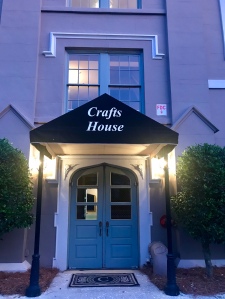
The original building was designed by architect Edward C. Jones, but it burned to the ground two years later. The present four-story Gothic Revival building is positively modern in comparison; it was built in 1881 and said to be designed to closely resemble the original. (Our hosts have an 1828 book of writings of William Crafts at the house!)
Thus, we temporarily entrusted our Casita to the driveway just across the Ashley River belonging to a wonderfully accommodating Matt Lee of Lee Brothers fame. (Matt and brother, Ted, are the James Beard Award–winning authors, Unique Eats stars on the Cooking Channel and founders of Boiled Peanuts Catalogue, a mail-order Southern food company.) Matt claimed that his driveway was unused, that he and his wife park on the street, and so our sweet Casita rested for six precious days under the calming shade trees of West Ashley just 10 minutes from downtown Charleston.
It was clear within minutes of our first walk downtown that we were back in the South, as opposed to Florida, where nearly everybody is a transplant from the Northeast. Motorists wave in acknowledgement, just like in Texas. When you’re walking, they greet you on the street with a smile and an extra comment, like “howyadoin’?” or “beautiful day, isn’t it?”
At one point, Georges sneezed twice as we walked across Broad Street. The construction worker near Burbage’s Self Service Grocery said bless you on one side of the street and the utility worker in front of a private home God-blessed him from the other side of the street.
That’s hospitality.
I was taken by all the lovely piazzas. These are like open-air porches on the side of the houses, except they’re called piazzas, not porches. They feature a formal door at the front, which makes you think you’re about to enter the interior of a house, but really it just opens up onto the open-air porch…er…veranda…er…piazza.

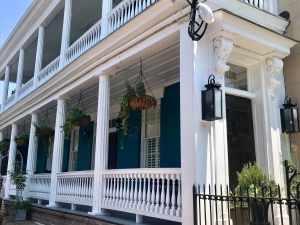
They are designed to provide shade for the hottest side of the houses, usually on the west or south walls. They made me want to sip lemonade and rock away the afternoon…. I took way too many pictures of them.




Living right downtown for six days allowed us to bike the area, too, though Charleston isn’t particularly bike friendly. (Streets are narrow, bike paths non-existent and sidewalks an obstacle course.) Still, we managed to cycle around Colonial Lake, up King Street, along the City Market and over to Harris Teeter’s mega-grocery (think Whole Foods).
We also pedaled through the Charleston City Marina and across Broad Street to Meeting Street. This is called “four corners of law” as there is a federal building on one corner, a county court on the next, City Hall on a third and St. Michael’s church on the fourth. All are historic, portions dating to the 1600, all free to visit.
It was in these buildings that a 22-year-old neo-Nazi was tried for massacring nine people in 2015 during Bible study at the Emanuel African Methodist Episcopal Church (photo below) and a white Charleston cop stood trial for the murder of 30-year-old Walter Scott, an unarmed black man gunned down as he fled a traffic stop. (In the first case, the murderer was sentenced to life in prison without parole; in the second, the ex-cop was sentenced to 20 years.)
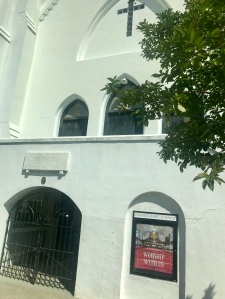
We pedaled back along Savage Street and up Tradd Street to Rainbow Row and Waterfront Park, where we watched the dolphin swim, the pelicans dive and the children frolic in the huge city fountains.
Friends – new and old
Who knew Apple would become such a network for meeting interesting people? We’venow taken Apple classes in four cities (Dallas, New Orleans, Miami, Charleston) and we’ve met fascinating people in each place, many of whom we continue to correspond with long after our classes together.
Our Apple coach this time was Derek Daisey, a musical artist when he’s not doing Apple stuff. He was typically great – fun and informative – in fielding our accumulated questions about smoothing our usage of programs like Pages, Notes and Numbers on our iPad Pros.
The only other student in our Studio Hours/All Projects class was a woman named Tania. Semi-retired, she and her husband spend 2-3 months in Charleston each spring. Turns out she’s from Holland, her husband from Montreal. By the end of the class, G had invited them to dinner the following night.
It was a lovely evening. We enjoyed swapping stories and learning about what it’s like living in another part of the country. We were collectively aided and abetted, of course, by G’s outstanding dinner of fresh corvina (aka red drum) with fresh veggies and fingerling potatoes in beurre blanc.

Two days later, Tania and Michael picked us up in the afternoon and gave us a four-hour tour of their favorite haunts just across the dramatic Ravenel bridge in Mount Pleasant. We bird watched from Shem Creek and spied on the boats and bikini-clad paddle boarders.




We also checked out the beauty of Sullivan Island, where we enjoyed some deliciously rich gelato at BeardCat Sweet Shop.

There’s nothing better than seeing a city through the eyes of those who love it. Tania and Michael drive nearly 2,500 miles – each way! – to revel in Charleston’s charms each year…. We expect to check in again with them in L.A. as we tool down the Pacific coast this fall.
The very evening we were with Tania and Michael we got a surprise email from good friends Madeleine and Frank from Dallas. They’re in the middle of their own months-long RV road-trip and had a sudden itinerary change that had them unexpectedly lighting in Charleston for 48 hours. Were we around by any chance?
Talk about serendipity!
What did we do? We invited them to dinner, of course.
Madeleine and Frank had recently circumnavigated the Great Lakes and so had special affinity for our Year on the Edges of America itinerary. We spent a lovely evening comparing campground notes, trading travel tips and sharing impressions about the wonders of the world.

Dessert was flamed; a perfect conclusion to the passions of the evening.
All in all, it’s been a wonderful interlude. We’ve loved the full kitchen, the washer/dryer, the respite from mosquitos and no-see-ums – and the access to a local dentist.
We treated ourselves to a lovely dinner at Le Farfalle our final night, per Matt Lee’s recommendation, and it was the perfect Charleston punctuation point. The lowcountry version of the Old Fashioned I ordered was excellent – bourbon, madeira, salted maple, black walnut bitters. They were out of the Prosecco on the menu but Prosecco Prima Terra that they substituted was better, sparkling and dry – and $10 less expensive.
We sat on the patio amid the sparkling lights woven into the trees, caressed by a lovely cooling breeze. I’d never had octopus carpaccio before and this was worth the wait. The aspic was firm but delicate, sliced exceedingly thin, featuring roasted tomatoes and pickled eggplant.

My main course was the branzino filet with shishito peppers, herbs, broccoli rabe and a special citrus emulsion. G ordered the quail alla modena – two birds, richly marinated, served with prosciutto, a mix of delectable mushrooms and parmigiana polenta. We shared a badly named but excellently executed “cheesecake” dessert featuring banana pudding with vanilla wafers and brown sugar caramel.
We didn’t walk home until close to midnight; it was an excellent way to wrap up a wonderful week in the city.
But we miss our beloved Casita. And we’ve itchy feet. It’s time to move on.
We’re ready resume our crawl up the Atlantic coast. Who knows what wonders await.

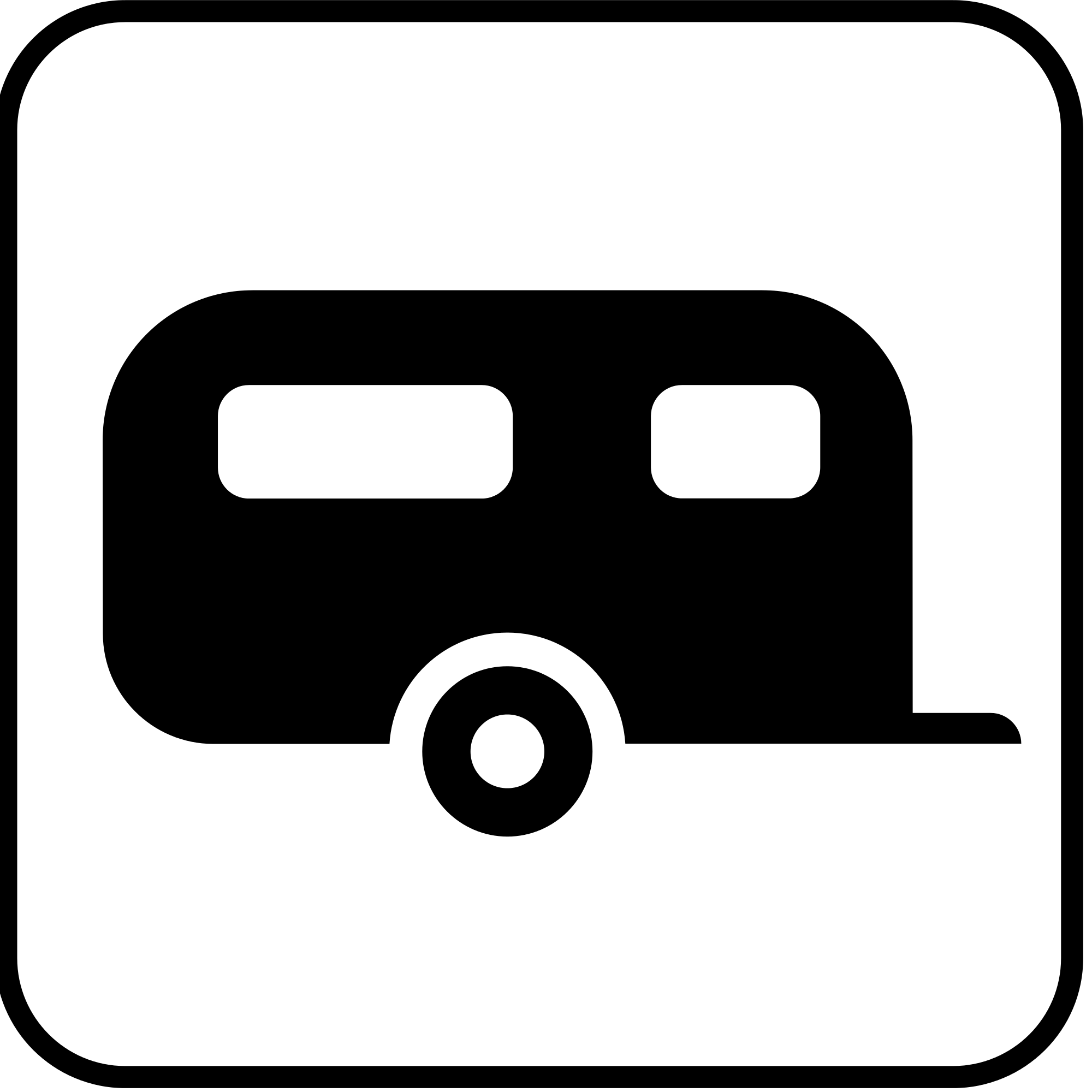
Wish there was a “thumbs up” button on your posts. Just to let you know I enjoyed it -your writing and info! 👍🏼
LikeLiked by 1 person
So glad to read your comment. More posts coming!
LikeLiked by 1 person
What a wonderful post. I enjoyed a trip to Charleston and Savannah when we lived back east and like you felt the European and more formal vibe of Charleston and the street culture of Savannah. Was amazed to learn that S. Carolina was founded partly because of religious freedom and many churches were founded with 2 people —a biblical reference. We went to the Magnolia plantation and on a boat tour of the rice “fields of gold” our tour guide, a retired high school history teacher, referred to the Civil War as the “great unpleasantness.” That was an amazing surprise. In Charleston the tour guides were not as open about slavery, other then in the museum, as the tour guides were in Savannah. It was interesting that most of the tours and many venues were run by retirees. I know many retire in the area.We were given a more honest view about “ the peculiar institution” a reference to slavery in Savannah.
We enjoyed both cities, the beauty of the places, architecture, gardens, food, history, culture and vibrancy So glad you had a great time. Am enjoying your ride, “postcards” travels, and
look forward to seeing you in November. Best to both of you.
LikeLiked by 2 people
Thanks for the careful read, Randee! Glad you enjoyed the post. Yes, looking forward to seeing you later this year!
LikeLike
Loved reading your post! I have never been to Charleston but plan to visit in the next year. I loved Savanna and want to go back. I just bought a 2012 17′ Casita SD and haven’t camped in it yet. I had a 16′ for the last 2 years and loved it but wanted a bigger bed & frig. Can’t wait for my first trip in the new one in 2 weeks!
LikeLiked by 2 people
Thank you, Linda. Congratulations on your new purchase! We will be rooting for your next grand adventure. We to have a spirit deluxe, but ours is a 2007. Couldn’t love it more.
LikeLike
Absolutely lovely post! Makes me want to visit both cities. You had me drooling over food descriptions. So glad you are having a wonderful time.
LikeLike
Thanks, Marilyn. So glad you enjoyed the post! It’s great to “have you along” on the trip. Hope all is well with you!
LikeLike
Great post! Love the juxtaposition of the sunshine and shade cities. It was so wonderful to cross paths with both of you and to enjoy such a fun evening and fabulous meal. Perhaps we shall meet again further north on the perimeter!
LikeLiked by 1 person
Thanks, Madeleine! Glad you liked the post. We’ll look for you “on the trail again.”
LikeLike
Amazing Amazing! We are loving the Posts……
LikeLiked by 1 person
Thanks, Ka and LL! Glad you’re enjoying the posts. I like writing them. We draw inspiration from your family travel adventures from years ago!
LikeLiked by 1 person
Makes you want to pack up and head to Charleston!!
LikeLiked by 1 person
Thanks, Bridge Buddy. You’d have a great time.
LikeLike
We loved this! You nailed Charleston! Next time let’s go together. Much Love, L and W
LikeLiked by 1 person
Thanks, Liza. You’re the best!
LikeLike